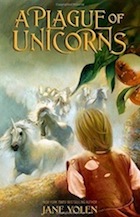
A Plague of Unicorns
PLAGUE OF UNICORNS
Zonderkidz (December 23, 2014)
ISBN-10: 0310746485
ISBN-13: 978-0399167416
This began as a short story in 1994 called “An Infestation of Unicorns” in my collection HERE THERE BE UNICORNS. Not my first foray into unicorns (that would be poems and a novel called THE TRANSFIGURED HART). Then I met the Zonderkidz editor at the Texas Library Association meeting and we hit it off. The results ended up being this short medieval novel, about a duke’s young son, a bunch of marauding unicorns at an abbey’s orchard, and an unlikely hero who saves the day. It was great fun to rewrite (read, make longer) but the editor left halfway through the process and I had to get used to a new editor. The people at Zonderkidz were wonderful. And voila!
Fun Fact: My oldest granddaughter’s name was borrowed for the book: Glendon Alexandria Callan-Piatt.
Around the web:
What reviewers have said:
- “Yolen (Owl Moon) weaves a magical yet believable tale of myth and magic in this charming middle-grade fantasy. In the mythical kingdom of Callanshire, James, son of the Duke of Callander, is sent away at age nine to study at Cranford Abbey. The abbey, struggling to stay financially solvent, plans to make its extraordinary golden Hosannah apples into cider for sale. Unfortunately, unicorns also love these delicious apples. No matter how the monks try, they cannot get rid of the horned orchard raiders until James summons a singer named Sandy, who may have a way with unicorns. James is a hero to be emulated: he is curious, brave, and caring. His family and the monks are all well-drawn, with delightful details (James nicknames his tutor, Benedict Cumber “Cumbersome,” for his dry delivery of obscure facts; Alexandria, James’s sister, has eyes “like Spanish steel”). Though partially set in an abbey, this tale avoids an overt religious message. It does, however, offer a winsome example of how to live life responsibly.”–Publishers Weekly
- “Yolen (who simply cannot write a graceless sentence) displays her strengths here: poking fun at heroic stereotypes, celebrating curiosity and imagination, and revealing both the homely everydayness of the magical and the wondrous beauty of the ordinary.”–Kirkus